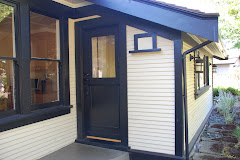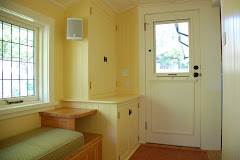Restoration of a heritage house is a challenge for any homeowner. Unless you're prepared to live in a museum, your house has to evolve to some degree to accommodate changes in living patterns. That means finding a balance, and every room raises different issues. How far you go in preserving what was originally there - trying to restore it to its former glory - is a judgment you get to make.
Over time, everything wears down to some degree, even if it's just the finish. It's often easier (and cheaper and less involving) to fully replace than it is to try to renew and restore what's there. But restoration is worth the extra time and cost if it retains a period feeling that's central to the meaning of your house.
This photo essay is about my attempt to find a balance between alteration and preservation in an important room in our 1913 bungalow. Designed by Saanich architect Hubert Savage as his own home, this small-but-artistic house's personality is defined by its living room. At about 16' by 16', it is the largest and most featured room in its roughly 1300 square feet. And it in turn revolves around its hearth, which is typical of California and Craftsman type bungalows of this era.
Keeping faith with the spirit of the California bungalow is the path I want to travel, but it's often not an easy one to tred. Buildings have to evolve to some degree in order to reflect major lifestyle changes: think how our kitchens have become major social spaces. New materials to replace worn or broken bits faithfully may not be available, leaving you looking for a way to have them manufactured. Older techniques are often long-forgotten (for example, limed mortars). So there's every temptation to substitute modern-looking materials for period feeling.
In bungalow idiom, the living room is the most masculine of the principal rooms: dark wood wainscoting and beamed ceilings (reminiscent of hunting lodges) and built-in bookshelves anchored by a prominent brick fireplace and heavy wooden mantel. This room is clearly intended as a cozy, restful retreat from the world, gathering people around a warm fire of an evening.
The room had suffered serial decorative muggings over its first century, fortunately mostly cosmetic, like jarring wallpaper on a frieze panel, tasteless Tudorization of the colour scheme, and the crude insertion of a mis-sized mirror to replace a built-in over the mantel. All were errors in taste that confused the period feeling, but relatively straightforward decorative fixes.
Restoration of the living room fireplace, which serves as a visual focal point and gathering place in the bungalow idiom, proved more challenging. It had been heavily used by the original owners, Hubert and Alys Savage, for its first forty years, as a principal source of heat until electric wall heaters came available (probably in the early fifties). Subsequent owners continued its use for festive occasions. By the time I acquired the house in 1988, the firebox floor was crumbling and some its fireproof bricks were loose. The outer hearth tiles were almost entirely loose, some chipped or broken.
Restoration began by having a skilled mason rebuild the firebox, conserving the original wall bricks that gave its interior a shaped, fitted look (you can't obtain these now and I was anxious to keep the period look). This picture shows the dining room fireplace, whose firebox was rebuilt at the same time as the living room (they share a common chimney stack). Note the fitted look from the original moulded fireproof bricks.
The job began with loosening the tiles that were still cemented in place, doing as little damage as possible. Once off, they badly needed cleaning up - first by soaking them for days in TSP-laced water, then by using a gentle abrasive to remove the mortar and stains. Inevitably, this removed the remaining original clear finish from the tiles. The broken tiles then had to be replaced. It took a long time to find a compatible colour and thickness for replacements, and in turn it was challenging to get them cut precisely to size. Partial tiles were required to fit under the base course of bricks (note the recess under the foot above), which gives the finished hearth a built-in look.
After some serious sweat equity, the tiles were finally ready to be placed back - the finesse here is that in the bungalow era in Victoria, the tiles were set nearly flush to one another, with only a hairline for mortar between them. This was the look I was anxious to preserve in the finished result, as it typifies the time. But this goal complicated all aspects of placement within the wooden frame (wider grout lines in current tiling forgive minor errors of placement).
The narrow grout lines are obvious here. I didn't get my tile placements perfectly level (when you rarely tile, you are unprepared for the flow of choices, and the finickier things tend to suffer as a result). On the other hand, the flaws don't leap to the eye of anyone other than the person who did the work!
Here the tiles have been grouted in, but the excess grout not yet washed off. Getting a grout/tile colour match is important to the finished look. Fortunately, that was nowhere near as difficult as getting replacement tiles made and allowing for their slightly greater thickness when applying them to the mortar bed.
Renewal began by painting-in the stripped sections of brick with the new, more era-compatible, colour. I immediately felt pleased with the choice and wanted to see the impact of a full coat.
A full coat reveals the form's true potential - note that this fireplace is anthropomorphic! By which I mean, there's a face in it, perhaps evoking the spirit of Vesta (ancient Italian hearth goddess) - a little trope by designer Hubert Savage.
It gave great satisfaction to disappear the jarring white paint entirely, and refresh the appearance of this defining feature of the room. It's painstaking work, best approached in an unhurried way. This is right at the end of the second coat.
An integrated whole once again, now that mirror, fireplace bricks and hearth have been either restored or renewed. To my eye, the result is consistent with the original character and feeling of the room. The cream colour gives a warmer, more cozy effect.
The best source of insight into the bungalow and its embedded values remains Robert Winter's The California Bungalow.













